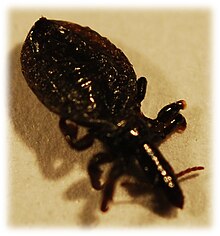Haematopinus
| Haematopinus | |
|---|---|

| |
| Haematopinus apri | |
| Scientific classification | |
| Domain: | Eukaryota |
| Kingdom: | Animalia |
| Phylum: | Arthropoda |
| Class: | Insecta |
| Order: | Psocodea |
| Suborder: | Troctomorpha |
| Infraorder: | Nanopsocetae |
| Parvorder: | Phthiraptera |
| Superfamily: | Anoplura |
| Family: | Haematopinidae Enderlein, 1904 |
| Genus: | Haematopinus Leach, 1815 |
| Species | |
|
see text | |
Haematopinus is a genus of insects in the superfamily Anoplura, the sucking lice.[1] It is the only genus in the family Haematopinidae,[2] known commonly as the ungulate lice.[3] All known species are of importance in veterinary medicine.[2] These lice are some of the most economically important ectoparasites of domestic animals.[4] Species infest many domesticated and wild large mammals, including cattle, horses, donkeys, swine, water buffalo, African buffalo, antelope, zebra, deer, and camels.[4] The species Haematopinus tuberculatus has great importance in the water buffalo breading, since this louse is specific to buffaloes, being the main ectoparasite of the species, with important sanitary and economic burden.[5][6] The Haematopinus tuberculatus is suspected to be involved in the transmission of diseases, such as anaplasmosis.[7] The parasites are found infesting buffaloes in greater concentrations around the ears, base of horns, side of the neck, around the scrotum or udder, and especially at the tip of the tail.[5]

Species include:[8]
- Haematopinus acuticeps
- Haematopinus apri
- Haematopinus asini – horse sucking louse
- Haematopinus breviculus
- Haematopinus bufali
- Haematopinus channabasavannai
- Haematopinus eurysternus – shortnosed cattle louse
- Haematopinus gorgonis
- Haematopinus jeannereti
- Haematopinus latus
- Haematopinus longus
- Haematopinus ludwigi
- Haematopinus meinertzhageni
- Haematopinus nigricantis
- Haematopinus oliveri – pygmy hog sucking louse
- Haematopinus oryx
- Haematopinus phacochoeri
- Haematopinus quadripertusus – cattle tail louse
- Haematopinus suis – hog louse
- Haematopinus taurotragi
- Haematopinus tuberculatus
References
[edit]- ^ Johnson, Kevin P.; Smith, Vincent S. (2021). "Psocodea species file online, Version 5.0". Retrieved 2021-11-05.
- ^ a b Scofield, A., et al. (2012). Infestation by Haematopinus quadripertusus on cattle in São Domingos do Capim, state of Pará, Brazil. Revista Brasileira de Parasitologia Veterinária 21(3), 315-18.
- ^ Haematopinidae (ungulate lice). Uniprot.
- ^ a b Meleney, W. P. and K. C. Kim. (1974). A comparative study of cattle-infesting Haematopinus, with redescription of H. quadripertusus Fahrenholz, 1916 (Anoplura: Haematopinidae). The Journal of Parasitology 60(3), 507-22.
- ^ a b Batista, Helder Ribeiro; Sarturi, Cristiane; Stelmachtchuk, Felipe Nascimento; Oliveira, Daniel Rocha; Morini, Adriana Caroprezo; Gennari, Solange Maria; Marcili, Arlei; Bastos, Fernanda Aparecida Nieri; Barata, Lauro Euclides Soares; Minervino, Antonio Humberto Hamad (2018-06-04). "Prevalence and risk factors associated with ectoparasite infestation of buffaloes in an Amazonian ecosystem". Parasites & Vectors. 11 (1): 335. doi:10.1186/s13071-018-2917-2. ISSN 1756-3305. PMC 5987401. PMID 29866180.
- ^ Minervino, Antonio Humberto Hamad; Zava, Marco; Vecchio, Domenico; Borghese, Antonio (2020). "Bubalus bubalis: A Short Story". Frontiers in Veterinary Science. 7: 971. doi:10.3389/fvets.2020.570413. ISSN 2297-1769. PMC 7736047. PMID 33335917.
- ^ Da Silva, Aleksandro Schafer; Lopes, Leandro Sâmia; Diaz, Jorge Damian Stumpfs; Tonin, Alexandre Alberto; Stefani, Lenita Moura; Araújo, Denise Nunes (June 2013). "Lice Outbreak in Buffaloes: Evidence of Anaplasma marginale Transmission by Sucking Lice Haematopinus tuberculatus". Journal of Parasitology. 99 (3): 546–547. doi:10.1645/GE-3260.1. ISSN 0022-3395. PMID 23050728. S2CID 37357955.
- ^ Haematopinus. Integrated Taxonomic Information System (ITIS).
